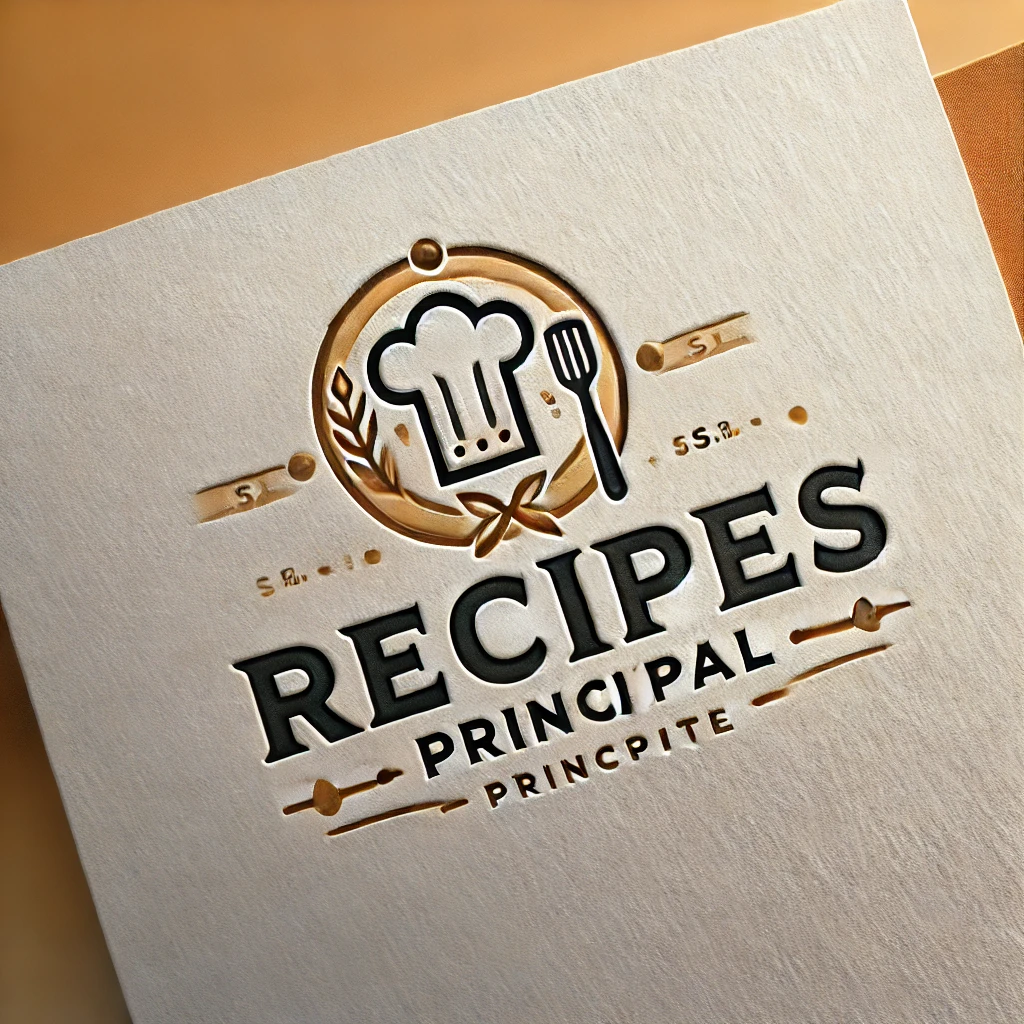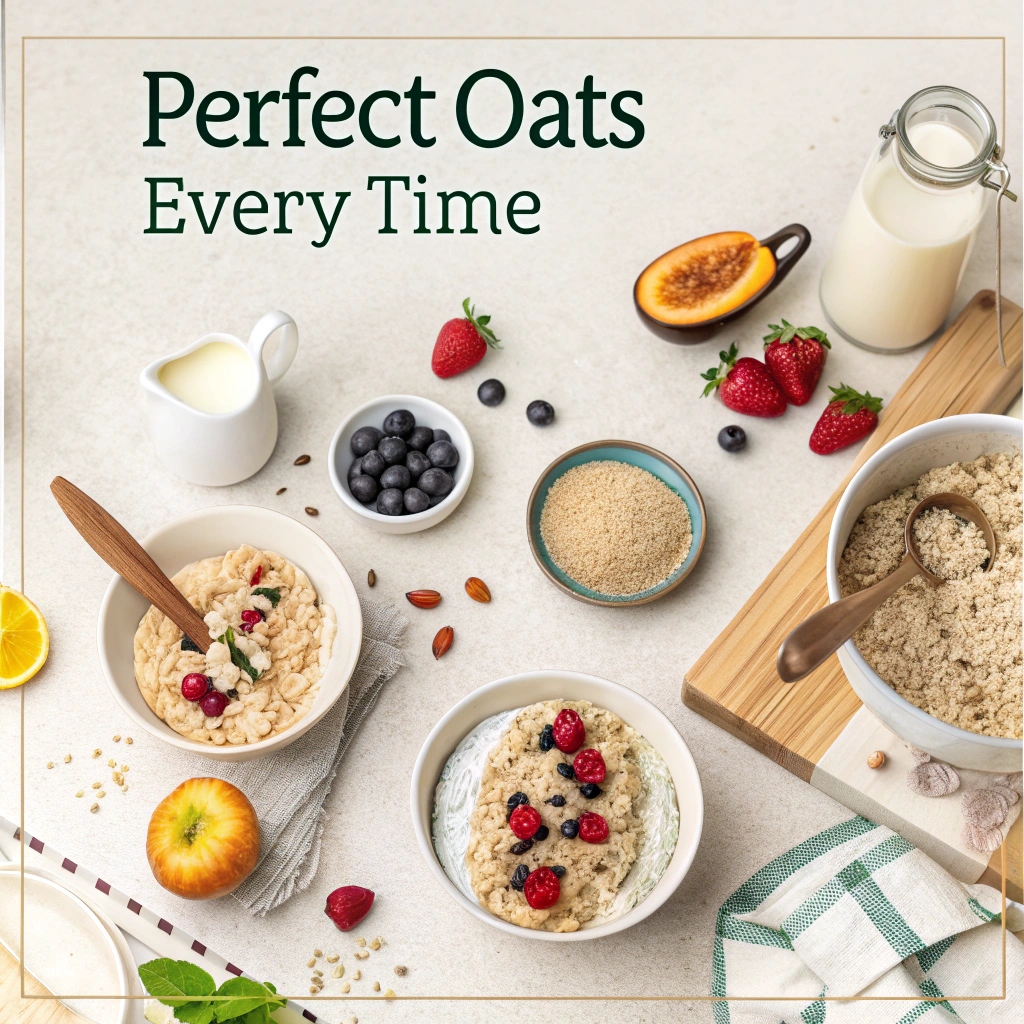Introduction
Oats are one of the simplest and healthiest breakfast options, loved for their rich flavor, versatility, and nutritional benefits. Whether you’re preparing a quick bowl of instant oats or savoring the hearty texture of steel-cut oats, getting the consistency and taste just right can be a game-changer.
In this guide, you’ll learn the secrets to making perfect oats every time. From selecting the right type of oats to mastering the cooking process, we’ll cover everything you need to know. Whether you prefer creamy or chewy, sweet or savory, this step-by-step approach will help you create a bowl of oats that’s delicious, satisfying, and tailored to your taste.
Why Oats Are the Perfect Breakfast Choice
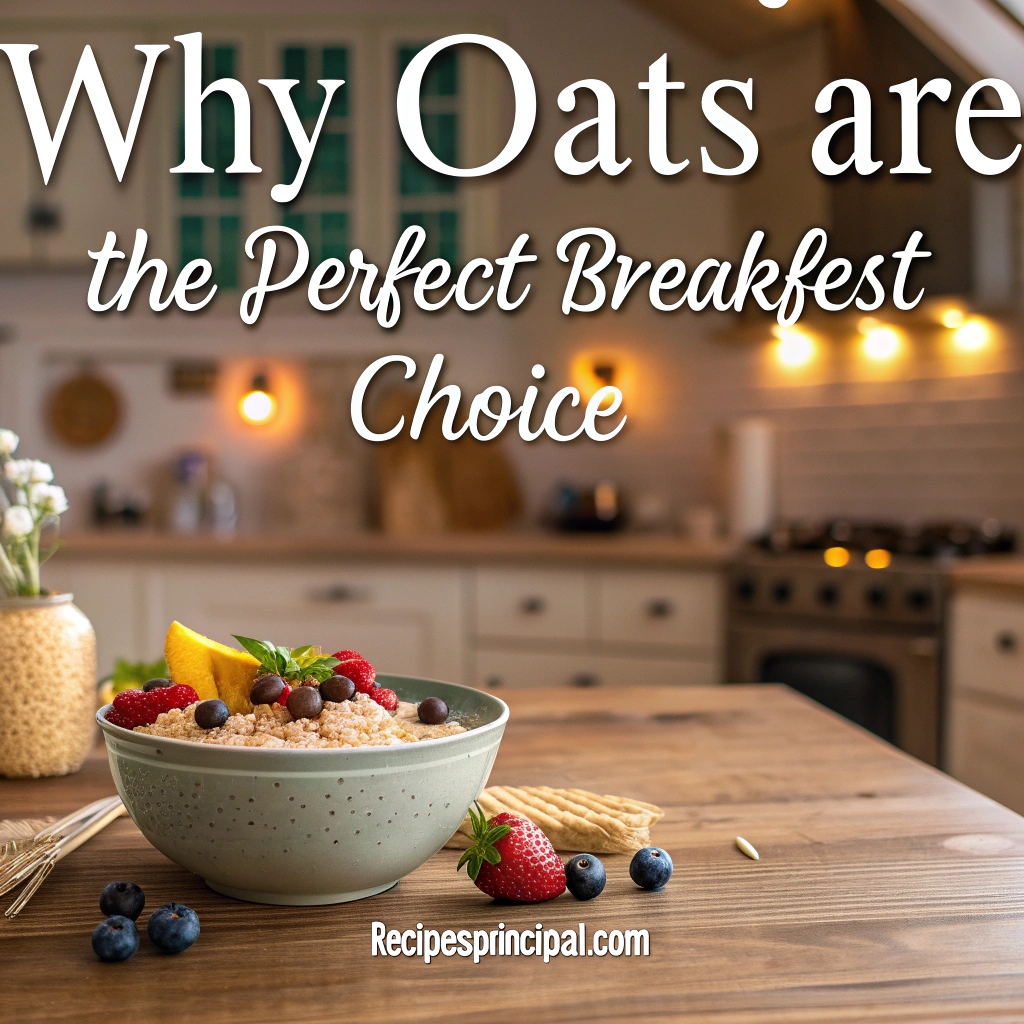
Making perfect oats every time may seem like a challenge, but it’s easier than you think! With the right ingredients and cooking techniques, you can consistently create oatmeal that’s creamy, flavorful, and exactly to your liking. This step-by-step guide will walk you through the process, ensuring that you can enjoy perfectly cooked oats on every occasion.
Rich in Fiber
Oats are packed with soluble fiber, particularly beta-glucan, which helps to lower cholesterol levels and supports heart health. Fiber also plays a key role in digestion, helping to regulate blood sugar levels and promoting a sense of fullness, making it easier to maintain a healthy weight. Eating fiber-rich foods like oats can keep you feeling satisfied longer, reducing the temptation for mid-morning snacks.
Excellent Source of Nutrients
Oats are a powerhouse of essential vitamins and minerals. They are an excellent source of magnesium, iron, and B vitamins, which help improve metabolism and support energy production throughout the day. Additionally, oats contain antioxidants, such as avenanthramides, which may help reduce inflammation and promote healthy blood circulation.
Versatile and Easy to Prepare
One of the best things about oats is their versatility. Whether you prefer a simple bowl of oatmeal or more creative recipes like overnight oats, baked oats, or even savory oat dishes, oats can be tailored to suit every taste. Oats can be prepared in a variety of ways—on the stovetop, in the microwave, or even in an air fryer—making them a time-efficient choice for busy mornings.
Supports Long-Term Health
Incorporating oats into your breakfast routine regularly can have long-term health benefits. Studies suggest that oats, due to their high fiber and antioxidant content, may help lower the risk of developing chronic diseases like heart disease, type 2 diabetes, and obesity. This makes them a great choice for individuals aiming to maintain a healthy lifestyle.
Budget-Friendly Option
Oats are an affordable breakfast staple that offers excellent value for money. Available in most grocery stores and in bulk, oats are affordable, making them accessible for families looking to eat healthily on a budget. They can be enjoyed with minimal added ingredients, or you can get creative and incorporate various toppings like fruit, nuts, or yogurt for extra flavor and nutrients.
Essential Tools You Need for Making Perfect Oats
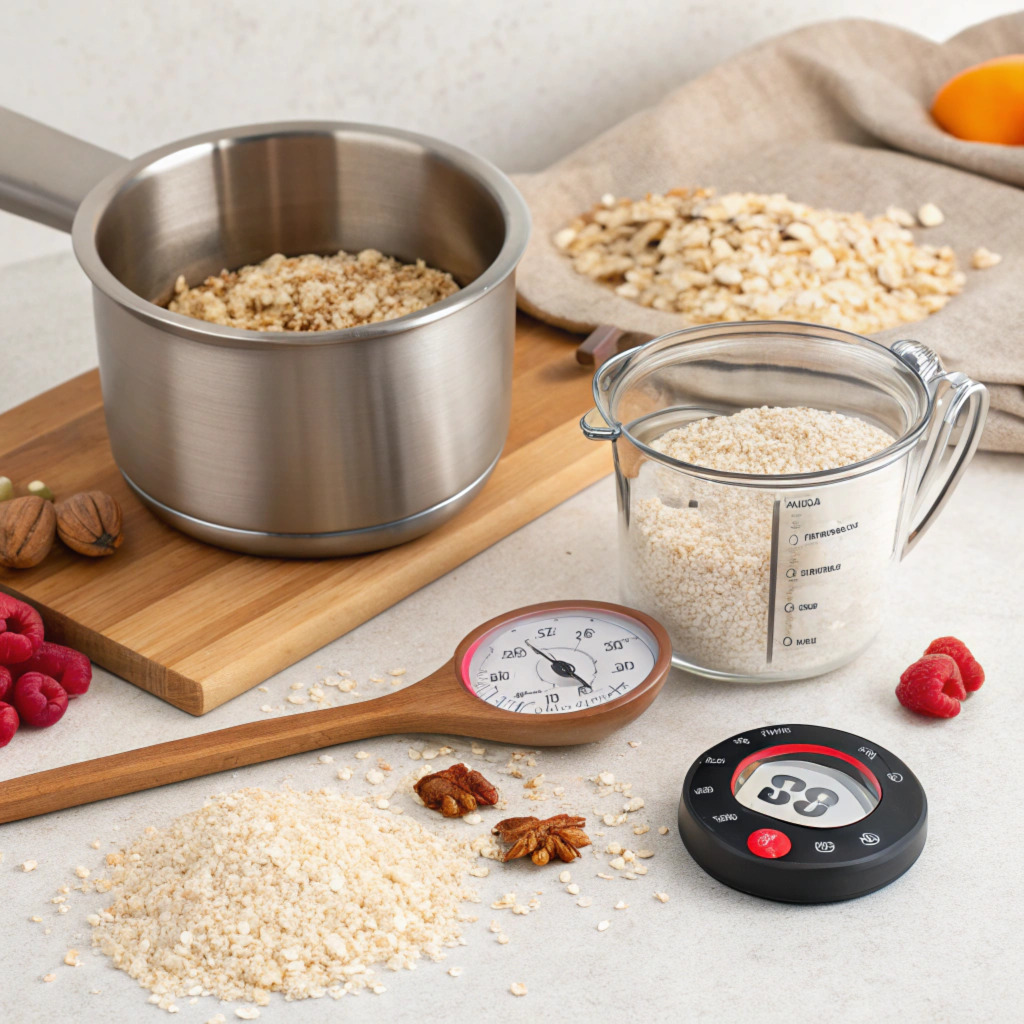
Having the right tools is essential for making the perfect bowl of oats. Whether you prefer a classic oatmeal recipe or like to experiment with new variations, the following tools will help you achieve the ideal texture and flavor every time.
A Quality Pot or Saucepan
A sturdy pot or saucepan is crucial for cooking oats on the stovetop. Look for one with a thick base to ensure even heat distribution and prevent your oats from burning. A medium to large-sized pot is ideal, giving enough space for the oats to expand and absorb liquid without boiling over. Choose a non-stick pan to make cleanup easier and prevent sticking. Learn more about selecting the right cookware for oatmeal at Cook’s Illustrated. For other tips on cooking with the best kitchen tools, check out our Essential Kitchen Gear Guide.
Microwave-Safe Bowl
If you’re short on time and prefer a quick breakfast, a microwave-safe bowl is a must-have. Oats can be quickly cooked in the microwave, making this tool an efficient option for busy mornings. Look for bowls that are deep enough to accommodate the oats as they expand while cooking and large enough to prevent spills. Find top microwave-safe bowls at The Spruce Eats. Want a quicker oatmeal recipe? Try our 5-Minute Microwave Oatmeal Recipe.
Measuring Cups and Spoons
Accurate measurements are essential to making perfectly cooked oats. A set of measuring cups and spoons ensures that you add the correct amount of liquid and oats for the perfect texture. Whether you prefer thick and creamy oats or a thinner consistency, precise measurements will help you achieve the desired outcome. For tips on measuring ingredients accurately, check out Food Network’s Guide. You can also find some great measuring tools in our Kitchen Tools Section.
A Stirring Spoon or Whisk
Stirring your oats while they cook is key to achieving a smooth, creamy texture. A wooden spoon or silicone spatula works best to gently stir the oats without scratching your cookware. For extra fluffiness, a whisk can help incorporate air and prevent clumping. Choose a tool that is heat-resistant and comfortable to handle for the best results. See more on choosing kitchen tools at Bon Appétit. If you need a guide to cooking the perfect oatmeal texture, visit our Oatmeal Cooking Tips.
A Lid for the Pot or Pan
A tight-fitting lid is necessary to keep the heat trapped inside your pot or pan while cooking oats. It helps regulate the temperature and moisture level, ensuring your oats cook evenly and don’t dry out. A lid is handy when making oatmeal, as it allows the oats to steam and soften. Explore more on the benefits of lids in cooking at The Kitchen. For more tips on cookware, check out our Cookware Recommendations.
An Oatmeal Pot or Slow Cooker (Optional)
For those who enjoy hands-off cooking or want to make a large batch of oats, an oatmeal pot or slow cooker is an excellent addition to your kitchen. These tools allow you to prepare oats overnight or while you’re busy with other tasks. Slow cookers, in particular, are perfect for creating creamy, well-cooked oats with minimal effort. Find slow cooker oatmeal recipes at Slow Cooker Reviews. You can also explore some of our Oatmeal Slow Cooker Recipes.
Toppings and Garnish Tools
Once your oats are cooked to perfection, it’s time to make them even more delicious. A good set of tools for adding toppings, such as a fruit corer, nut grinder, or honey spoon, will help you customize your oatmeal to suit your tastes. These tools allow you to easily add nuts, fruits, yogurt, or other toppings without hassle. For topping ideas and tools, visit Food52. Don’t forget to try our Oatmeal Topping Ideas for some delicious variations.
Step-by-Step Guide to Making Perfect Oats
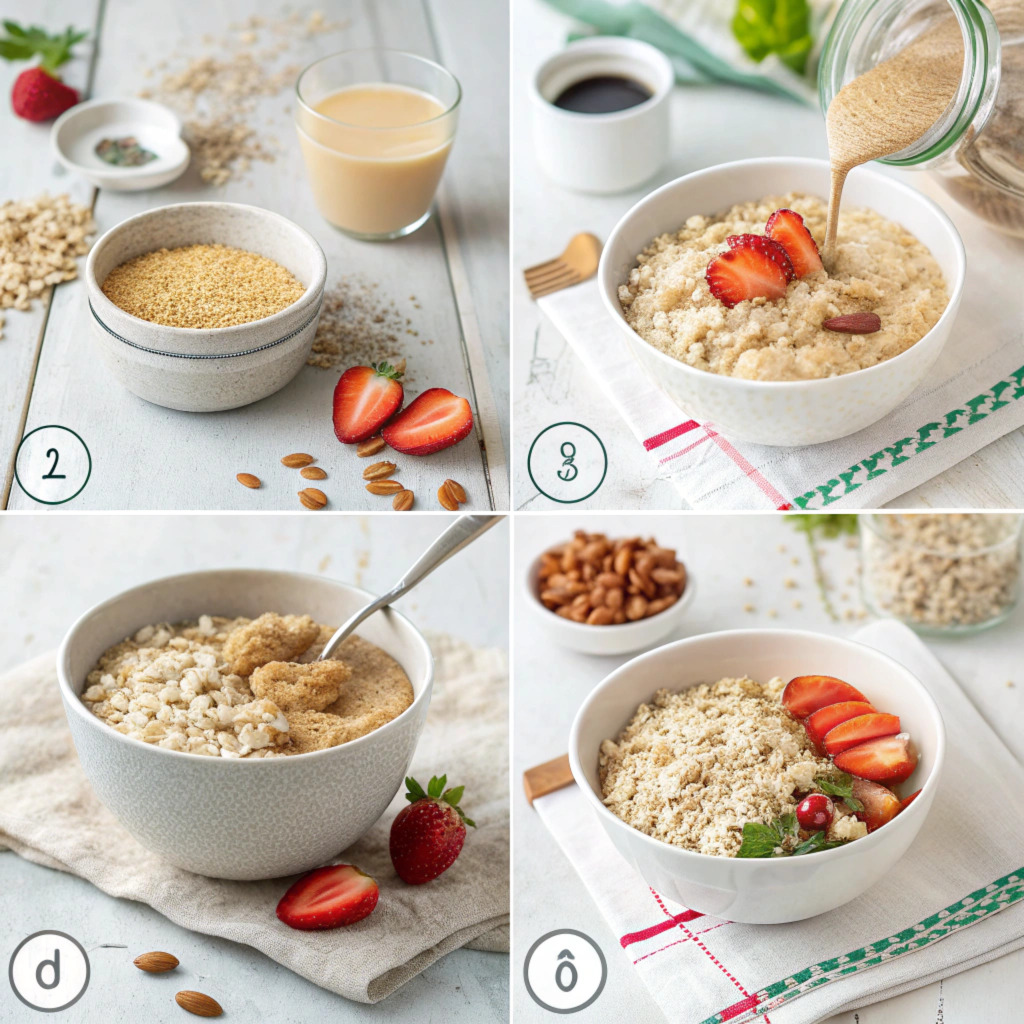
Making the perfect bowl of oats is simple when you follow the proper steps. Whether you’re preparing stovetop oatmeal, overnight oats, or baked oats, the process is straightforward to master. Here’s your step-by-step guide to creating a delicious and nutritious bowl of oats.
Step 1: Choose Your Oats
Start by selecting the type of oats you prefer. There are several varieties available:
- Rolled oats: These are the most common types and are perfect for stovetop oatmeal and microwave cooking.
- Steel-cut oats: These take longer to cook but have a chewier texture and nutty flavor.
- Instant oats: These cook the quickest but may have a softer texture.
- Quick oats: These are similar to instant oats but cook slightly slower.
Each variety has a slightly different texture and cooking time, so choose the one that suits your preference.
Step 2: Measure the Ingredients
For the perfect consistency, it’s essential to measure your oats and liquid correctly. A standard ratio is 1 part oats to 2 parts liquid (water, milk, or a combination of both). If you prefer a thicker texture, use less liquid; for creamier oats, add a bit more liquid.
For one serving, measure out:
- 1/2 cup oats
- 1 cup liquid
Step 3: Combine Oats and Liquid
Place the measured oats and liquid in your chosen pot or microwave-safe bowl. Stir gently to combine the ingredients. If you’re using a stovetop, make sure the pot is large enough to allow the oats to expand as they cook.
Step 4: Heat the Oats
- Stovetop method: Bring the mixture to a boil over medium heat. Once boiling, reduce the heat to a simmer and cook for about 5–10 minutes, stirring occasionally. For steel-cut oats, the cooking time will be longer (about 20–30 minutes). Stir frequently to prevent the oats from sticking to the bottom of the pot.
- Microwave method: Microwave the mixture on high for 2–3 minutes, then stir. Continue to microwave in 1-minute intervals until the oats have absorbed the liquid and reached the desired consistency. For steel-cut oats, you may need to adjust the time and use a lower power setting.
Step 5: Stir and Adjust Consistency
As the oats cook, they will absorb the liquid and begin to thicken. Stir occasionally to ensure they cook evenly. If the oats become too thick, add a bit more liquid to reach your desired consistency. For creamier oats, add a splash of milk or a dairy-free alternative.
Step 6: Add Flavor and Sweeteners
Once your oats are cooked to perfection, it’s time to add flavor. This is where you can get creative! Common additions include:
- Sweeteners: Honey, maple syrup, brown sugar, or stevia.
- Spices: Cinnamon, nutmeg, or vanilla extract for added warmth.
- Fruits: Fresh or dried fruits like berries, banana slices, or raisins.
- Nuts and Seeds: Almonds, walnuts, chia seeds, or flaxseeds for a crunch.
Stir in your chosen toppings and enjoy the flavors melding together.
Step 7: Serve and Enjoy!
Transfer your oats to a bowl, and top with your favorite garnishes. Whether you prefer a classic bowl of oatmeal or enjoy experimenting with toppings, the final step is to sit back and enjoy the perfect, comforting breakfast.
Delicious Oatmeal Toppings and Variations
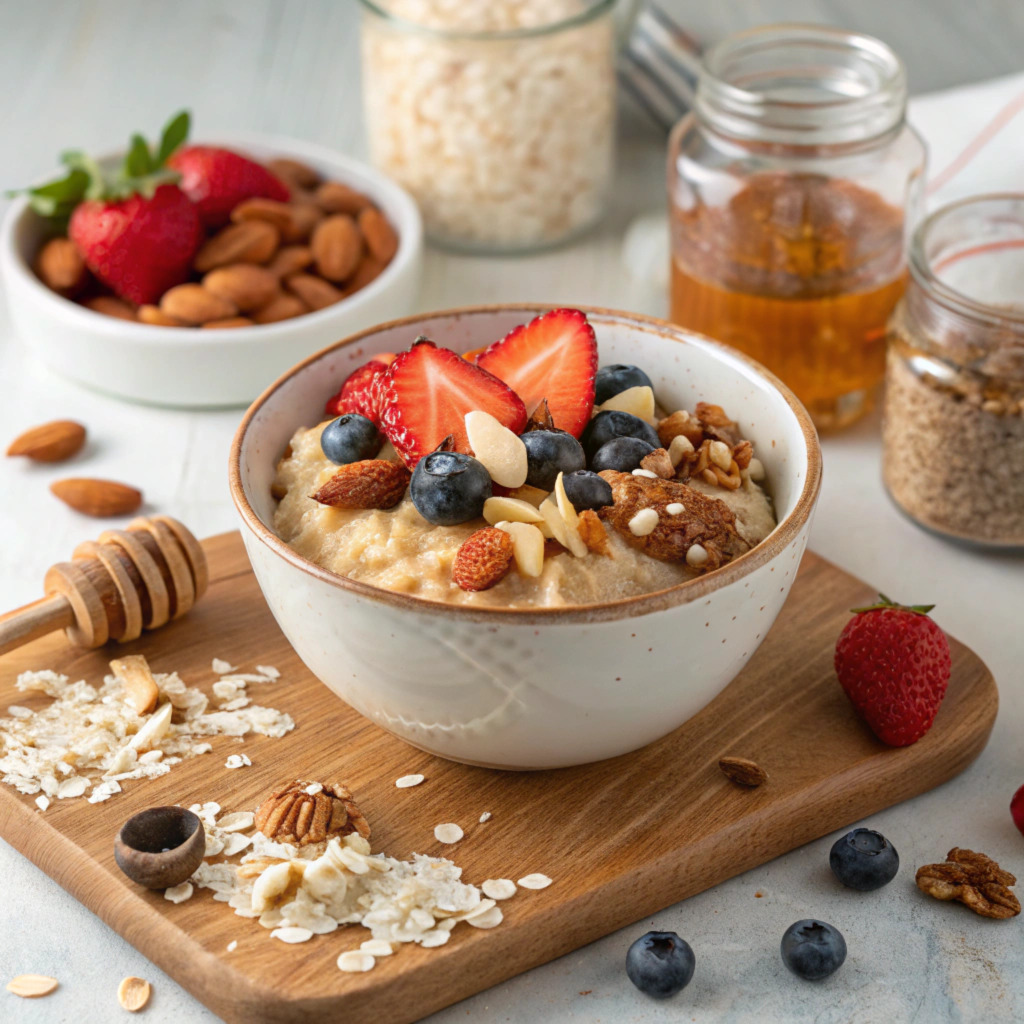
Delicious Oatmeal Toppings and Variations
Oats are incredibly versatile, and the toppings you choose can transform a simple bowl of oatmeal into a delightful and satisfying breakfast. Whether you prefer sweet, savory, or something in between, there are endless combinations to suit your tastes. Here are some delicious oatmeal toppings and variations to take your breakfast to the next level.
Sweet Toppings
If you have a sweet tooth, try adding these delicious toppings to your oatmeal for a burst of flavor:
- Fresh Fruits: Top your oats with fresh berries (strawberries, blueberries, raspberries), banana slices, or chopped apples. These fruits not only add natural sweetness but also provide vitamins and fiber.
- Dried Fruits: Dried apricots, raisins, cranberries, or figs offer a chewy texture and an extra dose of sweetness. Be mindful of portion sizes, as dried fruits are more concentrated in sugars.
- Nut Butter: A spoonful of almond butter, peanut butter, or cashew butter can make your oats creamier and add healthy fats. For an extra touch, drizzle a little honey on top for sweetness.
- Sweeteners: If your oats need a little more sweetness, try maple syrup, agave nectar, or a sprinkle of brown sugar. These can be drizzled over your oatmeal for a rich, sugary finish.
- Spices: Enhance your oats with ground cinnamon, nutmeg, or cardamom. These spices bring warmth and depth to the flavor. For a festive touch, try a dash of pumpkin spice or vanilla extract.
Savory Toppings
For those who prefer a savory breakfast, oatmeal can easily be transformed into a hearty, savory dish. Here are some options:
- Eggs: A soft-boiled or poached egg on top of savory oats adds protein and richness. You can also stir in scrambled eggs for a creamy texture.
- Avocado: Sliced or mashed avocado makes a creamy, nutritious topping that pairs perfectly with savory oatmeal. Add a sprinkle of salt, pepper, or chili flakes for extra flavor.
- Cheese: Grated cheese, like cheddar, Parmesan, or feta, adds a savory, melty component to your oatmeal. For a more complex flavor, try a tangy blue cheese or goat cheese.
- Vegetables: Add sautéed mushrooms, spinach, kale, or roasted tomatoes to your oatmeal for a nutrient-packed breakfast. Vegetables like zucchini, bell peppers, or onions work well when cooked and seasoned.
- Herbs and Spices: Fresh herbs like parsley, chives, or cilantro can bring a burst of freshness to savory oats. A pinch of smoked paprika, garlic powder, or even a drizzle of soy sauce can add depth to the flavor.
Protein-Packed Toppings
For a more filling and balanced breakfast, include some protein-rich toppings to fuel your day:
- Nuts and Seeds: Walnuts, almonds, chia seeds, or flaxseeds add a satisfying crunch and a boost of healthy fats and protein. Toast them lightly for an extra depth of flavor.
- Greek Yogurt: A dollop of Greek yogurt makes your oats creamy and adds a boost of protein. Choose plain yogurt for a less sugary option, or go for flavored varieties for an extra layer of taste.
- Cottage Cheese: This high-protein topping makes your oatmeal extra creamy and offers a savory contrast to sweet toppings, such as fresh fruit or honey.
Fun Variations
Switch things up with some creative oatmeal variations:
- Overnight Oats: Prepare your oats the night before and let them soak in milk or yogurt for a convenient, no-cook option. In the morning, top with your favorite fruits, nuts, or sweeteners.
- Baked Oats: For a warm, cake-like oatmeal experience, bake your oats in the oven with ingredients like mashed banana, egg, and a splash of vanilla extract. Top with fresh fruit or a drizzle of maple syrup.
- Smoothie Oats: Blend your cooked oats with fruits like bananas, berries, or mango for a smoothie bowl that combines the best of both worlds. Top with granola or coconut flakes for added texture.
Troubleshooting Common Oatmeal Mistakes
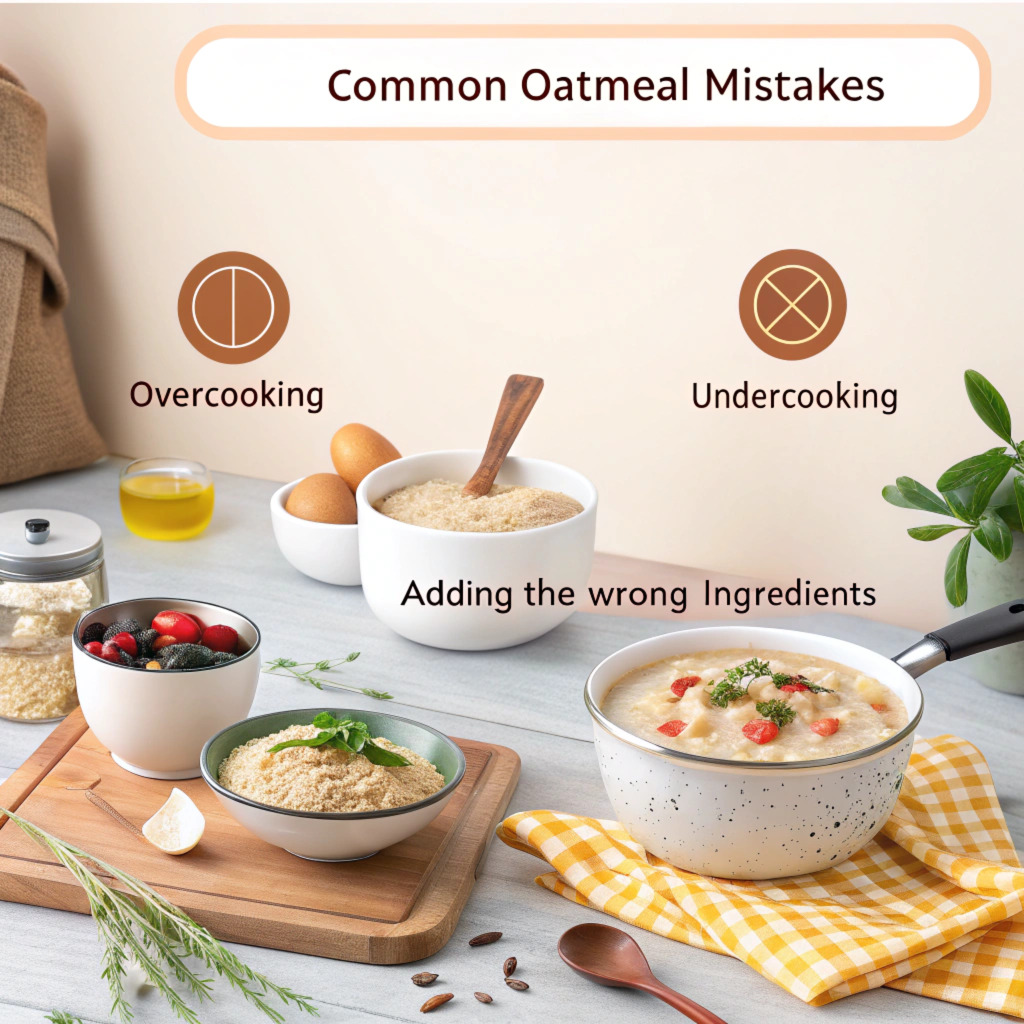
While making oatmeal is a simple process, sometimes things don’t go as planned. Whether it’s mushy oats or clumpy texture, there are a few common mistakes that can occur while cooking oats. Here’s how to troubleshoot and fix those issues to ensure you always make the perfect bowl of oatmeal.
- Oats Are Too Watery
Problem: Your oatmeal is too thin and watery, and the oats haven’t absorbed enough liquid.
Solution: If your oatmeal turns out too watery, cook it for a few more minutes over low heat to allow the oats to absorb the excess liquid. Stir regularly to ensure they don’t stick to the bottom of the pot. Alternatively, you can add more oats to thicken the consistency.
Tip: For thicker oatmeal, use less liquid in the initial preparation. A good rule of thumb is to use a 1:2 ratio of oats to liquid, but you can adjust this depending on your texture preference.
- Oats Are Too Thick
Problem: Your oatmeal turns out too thick and sticky, with the oats absorbing too much liquid.
Solution: Add more liquid, a little at a time, and stir well until you reach your desired consistency. This can be milk, water, or a dairy-free alternative like almond milk.
Tip: Steel-cut oats tend to absorb more liquid. You may need to use more liquid than the typical ratio, so don’t be afraid to adjust as needed.
- Oats Are Lumpy
Problem: Your oats are clumpy or have an uneven texture, with some parts more cooked than others.
Solution: Stir your oats frequently as they cook to ensure even liquid absorption. If you’re cooking oats on the stovetop, use a whisk to break up any lumps that form. For microwave preparation, stir halfway through cooking to prevent clumping.
Tip: Instant or quick oats can cook very quickly and may become clumpy if you don’t stir often. Stirring every 30 seconds in the microwave or every couple of minutes on the stovetop can help ensure even cooking.
- Oats Are Too Chewy or Hard
Problem: Your oats remain too chewy or hard even after cooking them.
Solution: This could be because you’re using the wrong type of oats or you didn’t cook them long enough. Steel-cut oats require longer cooking times (about 20-30 minutes), while rolled oats need only about 5-10 minutes on the stovetop.
Tip: Make sure you’re using the correct oat variety for your recipe. If you’re in a rush and need a quick breakfast, opt for rolled oats instead of steel-cut oats. If you’re using steel-cut oats, give them plenty of time to soften.
- Oats Are Burnt
Problem: Your oatmeal has a burnt taste or texture due to sticking to the bottom of the pot.
Solution: This is usually caused by cooking on too high of a heat or not stirring often enough. To prevent burning, lower the heat and stir your oats frequently, especially as they begin to thicken.
Tip: Use a non-stick pot or pan to reduce the risk of burning. If you’re cooking steel-cut oats, keep the heat on low and be patient, as they take longer to cook.
- Oats Taste Bland
Problem: Your oatmeal lacks flavor, even though you’ve followed the recipe.
Solution: Oats are quite neutral in flavor, so you need to enhance them with spices, sweeteners, and toppings. Adding cinnamon, nutmeg, or vanilla extract can boost the flavor profile. For sweetness, drizzle honey, maple syrup, or brown sugar over the top.
Tip: Remember to season your oats during the cooking process. A pinch of salt can enhance their natural sweetness and flavor, making them more enjoyable.
- Oats Overflow or spill-over
Problem: Your oatmeal is boiling over and making a mess in the kitchen.
Solution: This happens when the heat is too high, or the oats are cooked too quickly. Reduce the heat as soon as the oats start to bubble, and keep an eye on them while they cook. Stir frequently to prevent an overflow.
Tip: When cooking oats on the stovetop, use a large enough pot to allow room for expansion. A deep saucepan is ideal, as it will give your oats enough space to expand as they cook without overflowing.
Conclusion
Making perfect oats every time is simple when you follow the proper steps and troubleshoot common mistakes along the way. From choosing adequate oats to adjusting the cooking method for your desired texture, these tips and tricks ensure you create a satisfying, flavorful bowl of oatmeal each time. Whether you prefer a sweet, savory, or protein-packed variation, the possibilities are endless for customizing your oats to suit your tastes.
With the right tools, a little patience, and the right balance of ingredients, you can elevate your breakfast to a nutritious, delicious, and filling meal. So, next time you’re in the kitchen, follow these steps, explore new toppings, and enjoy the comfort and versatility of perfectly cooked oats every time!
